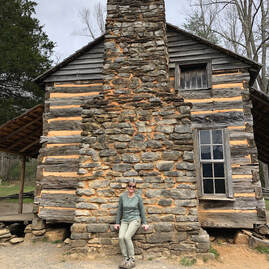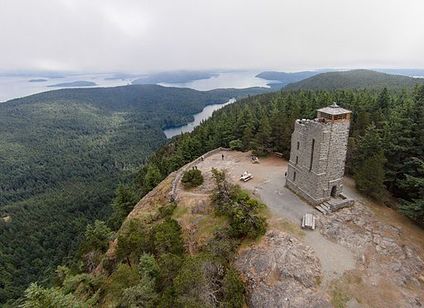 Me sitting along fireplace at one of the cabins. Cades Cove Me sitting along fireplace at one of the cabins. Cades Cove Before it became a national park that draws more than 12 million people a year, The Smoky Mountains National Park was home to the Cherokee, and after that, settlers from Europe. They settled in the ‘coves’ or flat valley areas in the mountains which allowed them to raise crops and livestock. They had churches, schools, unique cantilevered barns, henhouses, and cabins. Thankfully, a historian had the foresight to encourage the government to preserve homesteads in the park as cultural heritage sites. And that is where the research journey for my novel, The Truth of Who You Are began. What drew me first to the region (besides the majestic mountains) were the stories of the people who once inhabited Cades Cove. The community structures are still intact, preserved by the park for visitors to witness what it may have been like growing up in the shadows of the mountains. Regional museums have books about the people who once lived in the area, how they conducted business, and lived before the government bought them out to make the national park during the Great Depression. This eleven-mile circuit holds what remains of an entire community that once lived there: homes, corn cribs, barns, smoke, and spring houses.
0 Comments
4/26/2024 Following The Past to Where It Leads MeFollow the people from the past, the places they lived, worked, politics, public sentiment, changing landscape, and a narrative emerges that's worth telling in fiction. While climbing the viewing tower on Mount Constitution in Washington State, I had the opportunity to read the testimony of the men who built it and was hooked on their story. A particular sign caught my eye. It was a certificate of appreciation to one of the men who helped build the tower in 1936, thanking him for being part of an "Army of Youth and Peace" and "Awakening the People to Conservation and Recreation." The men who built the Mt. Constitution viewing tower and much of the infrastructure at the park, served in the U.S. Tree Army, a.k.a the Civilian Conservation Corps. (CCC). They led ordinary lives during an extraordinary time in U.S. history: the Great Depression. These men, recruited from cities, rural towns and Indian Reservations from 1933-1939, served the U.S. citizenry and had an enormous impact on cultural attitudes toward conserving the natural resources, especially National and State forests. Their nickname: The Tree Army, is apt; estimates are they collectively planted over three billion trees across the country. They fought numerous forest fires ravaging lands that were cut over and neglected by private lumber companies, and they prevented the decimation of the Great Plains agricultural lands through their soil conservation works. And they were paid $30.00/month and given three meals a day to do so. The rest, $25.00, was sent home to support their families. Five dollars a month may sound like a paltry sum, but during the Depression, it was a king's salary to these men. "Five dollars a month made me rich! I never had $5.00 before in my life." They were between the ages of 17-30. Some were World War I veterans. All were on public assistance. The U.S. Surgeon General estimated that 75% of the 100,000 men they examined in one year, were malnourished, prone to disease and exhausted from stress and the search for work. As one CCC alum wrote, the men had the mark of shattered ambitions and blasted hopes written on their faces. Although the CCC was touted as a jobs recovery program, and a way to keep men, particularly immigrants from roaming city streets looking for work, President Franklin Roosevelt also had a keen interest in preserving national park land. During his administration the Federal government acquired vast amounts of land and put it in the public domain. Soon, CCC camps were popping up in rural enclaves throughout the U.S. where there were plenty of public work projects to be done. Besides planting trees these men built roads, cabins, lodges, rest areas, bridges, and scenic byways in the parks. And their presence played a big role in improving the economies of the surrounding towns. Local supplies, carpenters, and tradesmen were employed to help build and service the CCC camps and the local businesses: theaters, barbershops, food stores, all catered to them. The Tree Army had an enormous impact on the recreation and tourist industry. Back in 1930 the Great Smoky Mountains National Park had about three thousand visitors a year. By the end of that decade, and due to their work, over 130 thousand visitors came to visit. Today the park welcomes over ten million visitors/year. While reading the testimony of the men in various written accounts, one can imagine how hard it was, especially for the city dwellers, to be sent into the woods, so far from home, even if they were surrounded by awe-inspiring beauty. Most didn't have a high school education and had never traveled outside their own city neighborhoods. One man stated he and the other recruits were pensive when they landed at a Washington port to be shipped out to the San Juan Islands. They didn't believe it when they were told by their camp leader the Islands were part of the United States, instead thinking they were being deported. When Orson Welles broadcast the War of the Worlds on radio in 1938, some of the men panicked, believing their homes in the Northeast were being destroyed by an invasion of martians. As one alum recounted, the boys from the east coast cities were screamin' and hollerin' around the camp. After reading about the men in the CCC, I went looking for fictional accounts and didn't find many. That's when I decided it was time to tell their stories. In April 2022, The Truth of Who You Are was published by Black Rose Writing. A coming of age story about hope and resilience and set at one of the CCC camps in the Smoky Mountains NP. Sources:
Olympic Mountain Range from Mt. Constitution, Moran State Park, Orcas Island. Photo credit Wikimedia: Lee317 Brinkley, Douglas. Rightful Heritage. HarperCollins 2016. Hill, Edwin. In The Shadow of the Mountain. Washington State University Press 1990. Jolley, Dr. Harley. The Maginficent Army of Youth and Peace. UNC Press. 2007. Maher, Neil. Nature's New Deal. Oxford University Press 2009. |
AuthorSheila Myers is an award winning author and Professor at a small college in Upstate NY. She enjoys writing, swimming in lakes, and walking in nature. Not always in that order. Archives
April 2024
CategoriesAll Adirondacks Algonquin Appalachia Award Cades Cove Canada Chestnut Trees Christmas Civilian Conservation Corps Collis P. Huntington Creativity Doc Durant Durant Family Saga Emma Bell Miles Finger Lakes Great Depression Hell On Wheels Historical Fiction History Horace Kephart Imagination National Parks Nature Publishing Review Screenplay Short Story Smoky Mountains Snow Storm Stone Canoe Literary Magazine Thomas Durant Timber Wilderness World War II Writing |
|
|
All materials Copyright 2022
Any reproduction, reprint or publication without written consent of author prohibited. |

 RSS Feed
RSS Feed